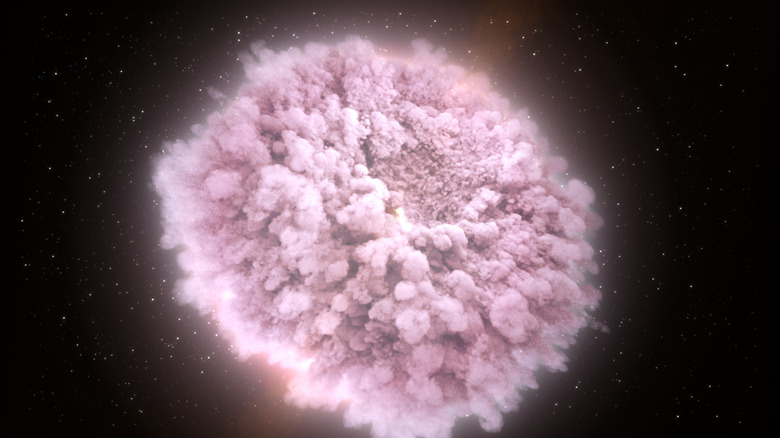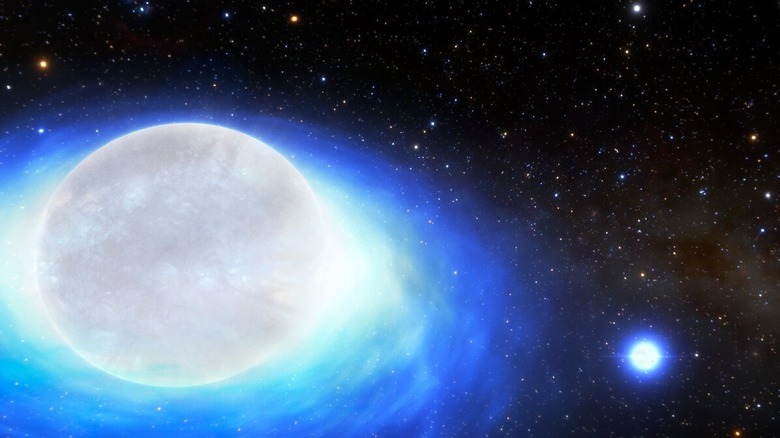Here's How Huge Explosions In Space Create Gold
When you picture the source of precious metals like gold and platinum, you likely think about digging them up from the ground or mining them from a cave. But how did those metals get in the ground in the first place? They must have come from somewhere. And according to one commonly held astronomical theory, the origin of at least some of these metals is from explosions deep in space.
Kilonovas are a type of explosion that is smaller than a supernova, but still epic in scale. A kilonova occurs when two neutron stars, or a neutron star and a black hole, collide. A neutron star is similar to a black hole in that it is an extremely dense core of a dead star, and is given its name because almost all of the star is made of neutrons. But it's not quite as dense as a black hole.
That's why when two black holes collide they create an explosion so powerful that they make ripples in space-time called gravitational waves and can send out huge explosions of light. When there is an explosion between a slightly less dense neutron star and a black hole, the explosion it creates is called a kilonova, which gives off gamma-ray bursts and emits light and other forms of electromagnetic radiation.
The brightness of a kilonova is between 1% and 10% that of a supernova, so they aren't the brightest events in the sky. But they are still bright enough to be seen from great distances, and astronomers are interested in studying them to learn how dense bodies merge and what the effects of such massive collisions can be.
How a kilonova creates gold
The power of a kilonova explosion creates heavy elements due to a process called rapid neutron capture, a type of nuclear reaction in which a nucleus sucks up nearby neutrons and then gives off gamma rays. This requires extreme conditions, like those found in a kilonova, which forms the heavy elements and then explodes them outwards. This sends the elements speeding off into space, where they can be incorporated along with clouds of dust and gas to form the building blocks of new planets.
In 2019, researchers identified the specific event which they believe seeded heavy elements like gold, platinum, and uranium on Earth. Two neutron stars collided 4.6 billion years ago in a part of the Milky Way close to where our solar system would form, at around 1,000 light-years of distance. The Earth itself formed around 100 million years later, incorporating the heavy elements that were sent shooting out into space by this collision.
These elements continue to exist on Earth today, making up around 0.3% of the heaviest elements found on the planet.
"This means that in each of us we would find an eyelash worth of these elements, mostly in the form of iodine, which is essential to life," said lead author of the research, Imre Bartos of Columbia University, in a research letter published in Nature.
Some researchers even believe that all of the gold and platinum found on Earth was created by kilonovae, though this is harder to prove.
How a kilonova forms
How does a kilonova happen though? What causes two neutron stars to collide into each other? The answer to these questions is revealed in recent research into a binary system called CPD-29 2176. A binary system is one in which two massive bodies such as stars, neutron stars, or black holes orbit each other, and this type of system is quite common in our galaxy.
However, this particular binary system, located 11,400 light-years from Earth, is unusual because it has just the right conditions to create a kilonova. It is thought to be one of just 10 systems in the Milky Way to have these conditions, making it a one in 10 billion system.
The system has a neutron star, which formed from a type of supernova called an ultra-stripped supernova, that pulled off much of the star's outer atmosphere when it exploded and left behind a neutron star core. But because this type of supernova isn't as powerful as others, it left behind the companion star, which orbits close by and is also on its way to becoming an ultra-stripped supernova.
This pair could eventually collide when the second star goes supernova, and that particular set of conditions would trigger a kilonova.
"For quite some time, astronomers speculated about the exact conditions that could eventually lead to a kilonova," said NOIRLab astronomer and co-author André-Nicolas Chené. "These new results demonstrate that, in at least some cases, two sibling neutron stars can merge when one of them was created without a classical supernova explosion."

